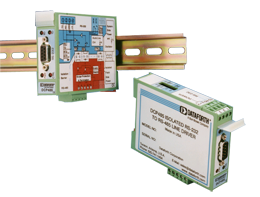Dataforth Adds 2-Wire Transmitter Interface Modules to 8B Family
Press Release
Release Date: Jul 7 2008
 Dataforth Corporation of Tucson, Arizona, has expanded its wide-ranging family of miniature SensorLex 8B isolated analog signal conditioners with 8B42 2-wire transmitter interface modules.
Dataforth Corporation of Tucson, Arizona, has expanded its wide-ranging family of miniature SensorLex 8B isolated analog signal conditioners with 8B42 2-wire transmitter interface modules.
Designed specifically to provide isolation for non-isolated 2-wire transmitters, each 8B42 module supplies power to a current transmitter, then isolates, filters, and amplifies the resulting process current input signal and provides an analog voltage output. To ensure high accuracy, current to voltage conversion takes place internally in the module.
Signal filtering in the 8B42 is accomplished with a 3-pole low-pass filter optimized for time and frequency response.
Other Key 8B42 Features Include:
- ±0.05% Accuracy (Typical)
- ±0.02% Linearity
- 1500Vrms Transformer Isolation & up to 40Vrms Field-Side Protection
- ANSI/IEEE C37.90.1 Transient Protection
- 5V Power (30mA Typical)
- +12VDC Loop Supply
- High-Level Voltage Outputs
- Low Output Noise
- Low Drift with Ambient Temperature
- -40°C to +85°C Operating Temperature
- CE Compliant
- UL Listing Pending
- Mix and Match Module Types on Backpanel
Like all modules in the SensorLex® 8B family, the 8B42 ensures fully functional Instrument Class® performance in a miniature package measuring only 1.11" x 1.65" x 0.40" (28.1mm x 41.9mm x 10.2mm). The small size makes the 8B ideal for embedded or portable applications such as mobile test stands, COTS military and defense applications, miniaturized security and surveillance systems, and embedded process controls for semiconductor manufacturing equipment.
The 8B42 modules are designed for installation in Class I, Division 2 hazardous locations. The modules are fully encapsulated and thus have a high level of immunity to environmental noise.
Operation and storage temperature for the 8B is -40 C to +85 C, and relative humidity range is zero to 95% noncondensing. All models are CE Compliant and meet the requirements of EN61000-6-4 (radiated/conducted emissions) and EN61000-6-2 (ESD/RF/EFT immunity). For operation in hazardous environments, North American Class I, Division 2, and European Group II, Category 3, approvals are pending.
Originally developed in response to customer requests worldwide for smaller, lower cost isolated signal conditioners, Dataforth's SensorLex® 8B family has grown to include 19 family groups with a total of 123 modules that interface to a wide variety of analog signals such as volt, millivolt, current, temperature (thermocouple and RTD), position, frequency, and strain measuring devices.
Housed in a solid, potted thermoplastic plug-in-the-panel package with flammability rating of UL-94 V-0, the 8B family of isolated signal conditioners is specifically designed to protect user equipment, while reducing electrical noise and enabling convenient system expansion and repair. All 8B modules offer dimensional stability over temperature, chemical resistance, and excellent stability over time; they do not require recalibration.
Design-in 8B accessories include a selection of standard and DIN backpanels (1, 2, 4, 8, and 16 channels) that provide screw-terminal inputs and outputs, as well as a DB25 header connector. The DB25 cables are available in 1, 2, or 7 meter lengths. Moreover, a power supply module in the same 8B form-factor is offered to accommodate input voltages of 7 to 34VDC and provide 5VDC output at 2A to power any combination of 8B signal conditioners. The 8BPWR-2 module plugs into its own socket on the backpanel. A DIN rail mounting accessory, the 8BP01, is offered as a 5VDC powered or 7 to 34VDC powered DIN rail mount carrier suitable for any 8B module. The 8B carrier can be mounted on any standard DIN rail (EN 50022-35 and EN 50035-G32).
Dataforth Corporation was established in 1984 and is a worldwide leader in the design and manufacture of signal conditioning, data acquisition, and data communication products for industrial and institutional markets.
For additional information, call 800-444-7644 toll-free, or e-mail sales@dataforth.com.
Original release: July 2008; updated January 2009
Was this content helpful?
Thank you for your feedback!






